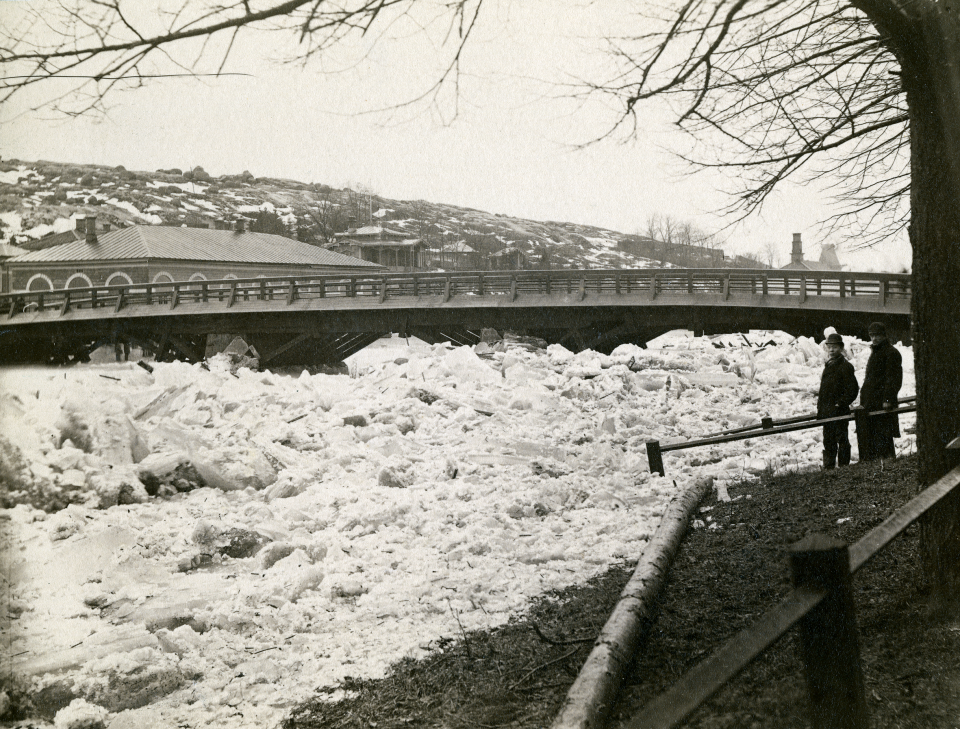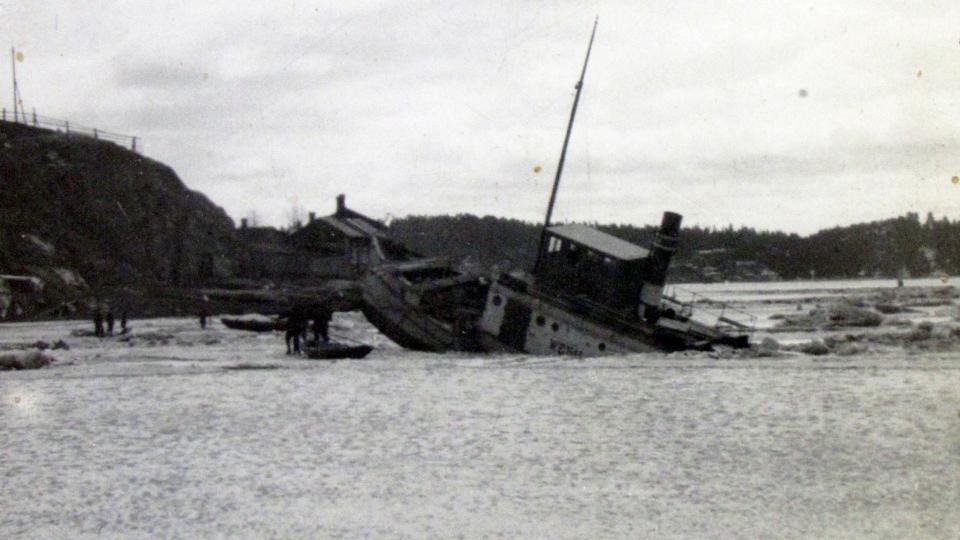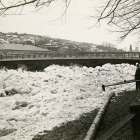On Tuesday 24 March 1903, the Aura River in Turku was declared ice-free, which was three weeks earlier than usual. Two local newspapers, Åbo Tidning and Åbo Underrättelser, labeled it as the earliest breakup in the memory of the oldest man. At that time, there were no official records of the breakups; however, the newspapers’ statements were not entirely wrong. A breakup chronology constructed in 2019 shows that the breakup in 1903 was the fifth time since 1749 that the river was declared ice-free in March. Hence, the timing of the event was exceptional and so was the breakup itself.

Gangways across the rivers are frequently used in Turku when they are possible. This photo is from 2018.
Gangways across the rivers are frequently used in Turku when they are possible. This photo is from 2018.
© 2018 Stefan Norrgård
Used by permission.
The copyright holder reserves, or holds for their own use, all the rights provided by copyright law, such as distribution, performance, and creation of derivative works.
On the morning of 23 March 1903, the ice on the Aura River started melting and the city authorities quickly removed the wintertime gangways across the river. Holes quickly developed in the ice near the Aura and Tuomiokirkko Bridges—the only bridges in the city center—and in the afternoon, the breakup gained momentum. As the ice pushed towards the estuary, an ice jam quickly developed in front of the two massive stone pillars of the Aura Bridge. This was the narrowest part of the river and where ice jams usually developed. The bridge was built in 1830, and after 73 years of spring ice breakups, the pillars were in bad condition. A discussion about the necessity of rebuilding the bridge started in 1892 but the decision was postponed. Meanwhile, to protect the bridge, a belt of steel was attached to one of the pillars in 1897, and in 1899, wooden icebreakers were built in front of both pillars. The extra set of breakers was considered necessary because the Tuomiokirkko Bridge (situated upstream of the Aura Bridge) was transformed into an arch bridge in 1899, which meant that the pillars of Aura Bridge had to withstand the entire force of the ice.

Ice jams usually occurred in front of Aura Bridge. This photo from 1897 shows the belt of steel that was attached to one of the pillars (the pillar further away from the camera) to hinder it from falling down.
Ice jams usually occurred in front of Aura Bridge. This photo from 1897 shows the belt of steel that was attached to one of the pillars (the pillar further away from the camera) to hinder it from falling down.
Photograph by Leo Björkman (1876–1961), 1897.
Courtesy of Åbo Akademi University Picture Collections, 1998/33:439.
Used by permission.
The copyright holder reserves, or holds for their own use, all the rights provided by copyright law, such as distribution, performance, and creation of derivative works.
On the evening of 23 March 1903, it started pouring, causing the water level in the river to rise swiftly. As the river expanded, the ice sheet broke, and at 4 a.m., it started moving from the upper reaches towards the Aura Bridge, taking with it everything in its path, such as private wooden landings, fences, and timber stored on the embankments. An hour later, pushing forward into the narrowest part of the river, the ice jam forced ice blocks up and over the quays. According to Uusi Aura, a local newspaper, the water level rose to about two fathoms (3.65 meters) above normal, and as the ice threatened the Aura Bridge, the fire department and the city engineer closely monitored the situation. At about 6 a.m., while most of the citizens were sound asleep, the ice jam at Aura Bridge broke.

This photo from 1882 shows what it probably looked like in 1903 as the ice threatened the bridge.
This photo from 1882 shows what it probably looked like in 1903 as the ice threatened the bridge.
Photograph by Ole Jonsen Aune (1837–1909), 1882.
Courtesy of Åbo Akademi University Picture Collections.
Used by permission.
The copyright holder reserves, or holds for their own use, all the rights provided by copyright law, such as distribution, performance, and creation of derivative works.
As the ice masses pushed towards the estuary, they destroyed the wooden breakers guarding the pillars. The bridge remained intact but as the flood pushed forward, it hit the ferry employed to transport people across the river, broke its moorings, and carried it downstream towards the ships that lay in winter storage in the river. The ferry crashed into Salo, a 30-meter-long steamer, which in turn crashed into Balder and Hebe, which were the same length. The ice also smashed into Carl von Linné, a 45-meter-long steamer, causing it to turn 90 degrees and, while being dragged by the bollards to which it was moored, Carl von Linné crashed into Necken, a 32-meter-long steamer. Thereafter, the ice-flood hit Wehmaa—a 22-meter-long steamer—moored with five chains, all of which broke. With the pressure of the ice, the ship listed, causing it to take in water. The ice flood carried the ship circa one kilometer to the estuary, where it came to a halt, half-sunken, at a 45-degree angle, not far from the passenger ferry, which had been dragged with the ice for almost two kilometers. The river lay quiet one hour after the ice jam at Aura Bridge broke. The ferry was towed back the following day, whereas Wehmaa—whose hull, against all odds, remained intact—was towed on 27 March. Fortunately, the breakup occurred when the city was sound asleep, which is why there were no casualties. For the citizens who depended on the ferry to get across the river, its absence probably generated some nuisance in the morning on 24 March. Besides the minor damages caused to private households, and the destroyed moorings and quays that were maintained by the city, most of the costs fell on the ship owners.

In the breakup in 1903, the ice-jam flood swept Wehmaa all the way to the mouth of the Aura River.
In the breakup in 1903, the ice-jam flood swept Wehmaa all the way to the mouth of the Aura River.
Unknown photographer, 1903.
Courtesy of Naantali Museum.
Used by permission.
The copyright holder reserves, or holds for their own use, all the rights provided by copyright law, such as distribution, performance, and creation of derivative works.
As in most riverine communities, the Aura River, occasionally referred to as the spine of Turku, plays an essential part in the economic growth and expansion of the city. Yet, every spring, the river also set the scene for possible chaos. As such, ice-jam floods are often sudden and therefore difficult to anticipate, but they provide novel perspectives on climate impact and variability in high-latitude riverine communities. At that time, the breakup in March 1903 occurred exceptionally early; however, the warming trend has since made breakups in March quite common. Since 1900, there have been 28 breakups in March, which is a stark contrast to the fact that there were only four breakups in March between 1749 and 1899.
How to cite
Norrgård, Stefan. “The Aura River Ice Jam in Turku, March 1903.” Environment & Society Portal, Arcadia (Spring 2020), no. 10. Rachel Carson Center for Environment and Society. doi.org/10.5282/rcc/8982
ISSN 2199-3408
Environment & Society Portal, Arcadia
 This work is licensed under a Creative Commons Attribution 4.0 International License.
This work is licensed under a Creative Commons Attribution 4.0 International License.
2020 Stefan Norrgård
This refers only to the text and does not include any image rights.
Please click on the images to view their individual rights status.
- Norrgård, Stefan, and Samuli Helama. “Historical Trends in Spring Ice Breakup for the Aura River in Southwest Finland, AD 1749–2018.” The Holocene 29, no. 6 (2019): 953–63.
- Kajander, Juha. “Methodological Aspects on River Cryophenology Exemplified by a Tricentennial Breakup Time Series from Tornio.” Geophysica 29, no. 1–2 (1993): 73–95.
- Lappalainen, Markku, ed. Aurajoki – ajan virta. Uusikaupunki: Newprint Oy, 2000.
- Symon, Carolyn, Lelani Arris, and Bill Heal, eds. Arctic Climate Impact Assessment. Cambridge: Cambridge University Press, 2005.
- Rokaya, Prabin, Sujata Budhatoki, and Karl-Erich Lindenschmidt. “Ice-Jam Flood Research: A Scoping Review.” Natural Hazards 94, no. 3 (2018): 1439–57.








